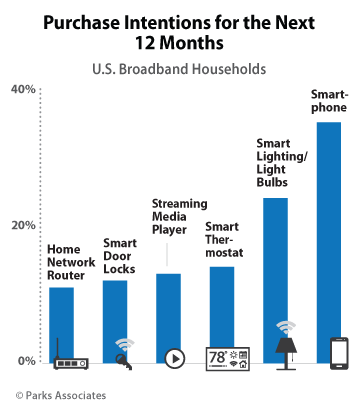Connected Home Market Continues to Expand offering New Opportunities for Ecosystem Players
 The connected home continues to expand as consumers adopt more and more connected devices at home. Parks Associates research shows that in 2014, smart home device penetration increased from 12% to 16% of all U.S. broadband households. Additionally, 37% of U.S. broadband households intend to buy one or more smart device in 2015.
The connected home continues to expand as consumers adopt more and more connected devices at home. Parks Associates research shows that in 2014, smart home device penetration increased from 12% to 16% of all U.S. broadband households. Additionally, 37% of U.S. broadband households intend to buy one or more smart device in 2015.
The smart home continues to grow due in large part to the massive advertising campaigns of service providers such as Comcast Xfinity, ADT, and Time Warner Cable. As a result of the new value proposition that smart features bring to the security environment, the professionally monitored security industry grew to 23% of all broadband households in 2014.
Other Parks Associates connected home research shows:
- 8% of U.S. broadband households own a smart thermostat
- There will be 1.6 billion video viewers worldwide by year-end 2015
- One-fourth of broadband households in the UK, Spain, and Germany find at least one smart home device very appealing
- Nearly 30% of U.S. broadband households own a connected health device
Manufacturers are adding connectivity to products in increasing numbers. What was novel eight years ago is commonplace today. Initially, many manufacturers add connectivity to premium-tier products as a way to differentiate and move the mix of product sales up from mid-tier products. Many first-generation products simply had remote monitoring and control capability via a mobile devices, but over time, manufacturers have added new services that simplify or automate operation. Some vendors have chosen to add additional sensors that, when combined with a cloud service and a mobile app, create significant value for consumers. Others have integrated third-party data and data analytics to create value.
Automatic door locks and motorized windows were once a feature introduced in only premium vehicles. Eventually, those features were cascaded down to mid-tier products, and then to value-tier products. Today, it would be challenging to find a vehicle that does not have automatic door locks and windows. Connectivity is following a similar path. What once started as a feature available in only premium products is now moving to the mid-tier. As the exponential improvements in processing power, memory, and bandwidth drive costs lower, eventually connectivity will be included in value-tier products. Even products that are not powered today will eventually include a tag or other form of connectivity.
Connected products are not a fad. They are here to stay and will continue to grow in numbers. Our data and the public data on smart home system providers, smart product manufacturers, and technology solution providers all show strong growth across multiple product and service categories.
For more insight into the growth of the smart home and the IoT, see Parks Associates' whitepaper study The Connected Consumer: Top Trends in IoT.
Further Reading:
- 360 View: Residential Security & Smart Home
- Smart Home Ecosystem: IoT and Consumers
- Over 50% of smart home device owners report interoperability very important
Next: New Innovations Spurring IoT Growth, but Lack of Awareness Remains Huge Obstacle
Previous: Smart Home Products Market Set to Double by 2017
Comments
-
Be the first to leave a comment.
Post a Comment
Have a comment? Login or create an account to start a discussion.


